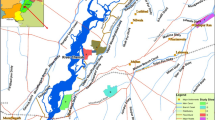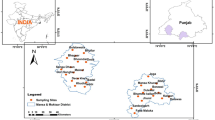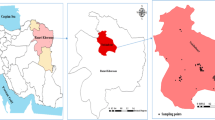Abstract
Most local people in the agricultural areas of Hua-ruea sub-district, Ubon Ratchathani province (Thailand), generally consume shallow groundwater from farm wells. This study aimed to assess the health risk related to heavy metal contamination in that groundwater. Samples were randomly collected from 12 wells twice in each of the rainy and the dry seasons and were analyzed by inductive coupled plasma spectrometry-mass spectrometry (ICP-MS). The concentration of detected metals in each well and the overall mean were below the acceptable groundwater standard limits for As, Cd, Cr, Cu, Hg, Ni and Zn, but Pb levels were higher in four wells with an overall average Pb concentration of 16.66 ± 18.52 μg/l. Exposure questionnaires, completed by face-to-face interviews with 100 local people who drink groundwater from farm wells, were used to evaluate the hazard quotients (HQs) and hazard indices (HIs). The HQs for non-carcinogenic risk for As, Cu, Zn and Pb, with a range of 0.004–2.901, 0.053–54.818, 0.003–6.399 and 0.007–26.80, respectively, and the HI values (range from 0.10 to 88.21) exceeded acceptable limits in 58 % of the wells. The HI results were higher than one for groundwater wells located in intensively cultivated chili fields. The highest cancer risk found was 2.6 × 10−6 for As in well no. 11. This study suggested that people living in warmer climates are more susceptible to and at greater risk of groundwater contamination because of their increased daily drinking water intake. This may lead to an increased number of cases of non-carcinogenic and carcinogenic health defects among local people exposed to heavy metals by drinking the groundwater.




Similar content being viewed by others
References
Agency for Toxic Substances and Disease Registry. (2000). Toxicological profile for arsenic (update). Atlanta, Georgia.
AOAC Peer-Verified Methods Program. (1998). Manual on policies and procedures, Arlington, Va., USA. http://www.aoac.org/vmeth/PVM.pdf. Accessed 04/10/2013.
Buchhamer, E. E., Blanes, P. S., Osicka, R. M., & Giménez, M. C. (2012). Environmental risk assessment of arsenic and fluoride in the Chaco province, Argentina: Research advances. Journal of Toxicology and Environmental Health, Part A, 75, 1437–1450.
Carlson-Lynch, H., Beck, B. D., & Boardman, P. D. (1994). Arsenic risk assessment. Environmental Health Perspectives, 102(4), 354–356.
Chang-Yu, C., Tsu-Kung, L., Yi-Chuang, C., Yi-Fen, W., Huey-Wen, S., Kuan-Hua, L., et al. (2010). Nickel(II)-induced oxidative stress, apoptosis, G2/M arrest, and genotoxicity in normal rat kidney cells. Journal of Toxicology and Environmental Health, Part A, 73, 529–539.
Chotpantarat, S., & Sutthirat, C. (2011). Different sorption approaches and leachate fluxes affecting on Mn2+ transport through lateritic aquifer. American Journal of Environmental Science, 7(1), 65–72.
Chotpantarat, S., Ong, S. K., Sutthirat, C., & Osathaphan, K. (2011). Effect of pH on transport of Pb2+, Mn2+, Zn2+ and Ni2+ through lateritic soil: Column experiments and transport modeling. Journal of Environmental Sciences, 23(4), 640–648.
Claesson, M., & Fagerberg, J. (2003). Arsenic in groundwater of Santiago del Estero—source, mobility pattern and remediation with natural materials. Master Thesis, Dept. of Land and Wat Res. Eng., KTH, Stockholm, Sweden, TRITA-LWRLEXL-03-05, p. 59.
Debernardi, L., De Luca, D. A., & Lasagna, M. (2008). Correlation between nitrate concentration in groundwater and parameters affecting aquifer intrinsic vulnerability. Environmental Geology, 54, 1081–1090.
Eriksson, J. E. (1990). Effect of nitrogen-containing fertilizers on solubility and plant uptake of cadmium. Water, Air, and Soil pollution, 49, 355–368.
European Centre for Ecotoxicology of Chemicals. (2001). Aquatic toxicity of mixtures. Technical report 80, Brussels, Belgium.
Filgueiras, A. V., Lavilla, I., & Bendicho, C. (2002). Chemical sequential extraction for metal partitioning in environmental solid samples. Journal of Environmental Monitoring, 4, 823–857.
Gibbs, R. J. (1977). Transport phases of transition metals in the Amazon and Yukon Rivers. Geological Society of American Bulletin, 88, 829–843.
Jaipieam, S., Visuthismajarn, P., Sutheravut, P., Siriwong, W., Thoumsang, S., Borjan, M., et al. (2009). Organophosphate pesticide residues in drinking water from artesian wells and health risk assessment of agricultural communities, Thailand. Human Ecological Risk Assessment, 15, 1304–1316.
Jeyaruba, T., & Thushyanthy, M. (2009). The effect of agriculture on quality of groundwater. Middle-East Journal of Scientific Research, 4(2), 110–114.
Kim, H. K., Yoon, E. K., Jang, J., Hwang, M., Kim, J. Y., Ha, J. H., et al. (2009). Assessment of heavy metal exposure via the intake of oriental medicines in Korea. Journal of Toxicology and Environmental Health, Part A, 72, 1336–1342.
Lim, H. S., Lee, J. S., Chon, H. T., & Sager, M. (2008). Heavy metal contamination and health risk assessment in the vicinity of the abandoned Songcheon Au–Ag mine in Korea. Journal of Geochemical Exploration, 96, 223–230.
Mandour, R. A., & Azab, Y. A. (2011). Toxic levels of some heavy metals in drinking groundwater in Dakahlyia Governorate, Egypt in the year 2010. International Journal of Occupational and Environmental Medicine, 2(2), 112–117.
Marcovecchio, J. E., Botte, S. E., & Freije, R. H. (2007). Heavy metals, major metals, trace elements. In L. M. Nollet (Ed.), Handbook of water analysis (2nd ed., pp. 275–311). London: CRC Press.
Mushak, P., & Crocetti, A. F. (1995). Risk and revisionism in arsenic cancer risk assessment. Environmental Health Perspectives, 103(7–8), 6834–6839.
Nakadaira, H., Nakamura, K., Mutoh, K., Yamamoto, M., & Katoh, K. (2000). Arsenic residues in well water 36 y after endemic arsenic poisoning. Archives of Environmental Health, 55(5), 364.
Nassef, M., Hannigan, R., Sayed, K. A. E., & Tahawy, M. S. E. (2006). Determination of some heavy metals in the environment of Sadat Industrial City. In: Proceedings of the 2nd Environmental Physics Conference, Alexandria, Egypt.
Natural Healing Site. (2010). Heavy metal toxicity. http://www.tuberose.com/Heavy_Metal_Toxicity.html. Accessed August 15, 2010.
Norkaew, S., Siriwong, W., Siripattanakul, S., & Mark, R. (2010). Knowledge, attitude, and practice (KAP) of using personal protective equipment (PPE) for chilli-growing farmers in Huarua Sub-District, Mueang District, Ubonrachathani Province, Thailand. Journal of Health Research, 24(2), 93–100.
Patriquin, D. G., Blaikie, H., Patriquin, M. J., & Yang, C. (1993). On-farm measurement of pH, electrical conductivity and nitrate in soil extracts for monitoring coupling and decoupling of nutrient cycles. Biological Agriculture & Horticulture, 9, 231–272.
Peplow, D., & Edmonds, R. (2004). Health risks associated with contamination of groundwater by abandoned mines near Twisp in Okanogan County, Washington, USA. Environmental Geochemistry and Health, 26, 69–79.
Pokkamthanam, A. S., Riederer, A. M., & Anchala, R. (2011). Risk assessment of ingestion of arsenic-contaminated water among adults in Bandlaguda, India. Blacksmith Institute Journal of Health & Pollution, 1, 8–15.
PCD, Pollution Control Department. (2000). Groundwater standards for drinking proposes. Manual inspection of contaminated groundwater standards for drinking proposes. Manual inspection of contaminated groundwater from waste disposal facilities, Ministry of Natural Resources and Environment.
PCD, Pollution Control Department. (2004). Ministry of Natural Resources and Environment. Drinking water standards. http://www.pcd.go.th/info_serv/en_reg_std_water01.html#s1. Accessed January 20, 2012.
Rapant, S., & Krčmová, K. (2007). Health risk assessment maps for arsenic groundwater content: Application of national geochemical databases. Environmental Geochemistry and Health, 29, 131–141.
Rashed, M. N. (2010). Monitoring of contaminated toxic and heavy metals from mine tailings through age accumulation in soil and some wild plants at Southeast Egypt. Journal of Hazardous Materials, 178(1–3), 739–746.
Rattan, R. K., Datta, S. P., Chhonkar, P. K., Suribabu, K., & Singh, A. K. (2005). Long-term impact of irrigation with sewage effluents on heavy metal content in soils, crops and groundwater—a case study. Agricultural Ecosystems and Environment, 109, 310–322.
Saipan, P., & Ruangwises, S. (2009). Health risk assessment of inorganic arsenic intake of Ronphibun residents via duplicate diet study. Journal of the Medical Association of Thailand, 92(6), 849–856.
Siriwong, W. (2006). Organophosphate pesticide residues in aquatic ecosystem and health risk assessment of local agriculture community. Doctor dissertation Program in Environmental Management (Interdisciplinary Programs), Graduate School Chulalongkorn University, Thailand.
Srithongdee, T., Chotpantarat, S., Siriwong W., & Siripattanakul, S. (2010). Nitrate and pesticide contamination of shallow groundwater under chilli field of Hua Rua, Ubon Ratchathani Province. In: Proceedings of the APRC-2010, Ubon Ratchathani, Thailand.
Stumm, W., & Morgan, J. J. (1996). Aquatic chemistry (3rd ed.). NY: Wiley.
Suesat, S. (2010). Distribution and potential mobility of heavy metals in soil and shallow groundwater aquifer in an agricultural area: A case study of Hua Rua Area, Changwat Ubon Ratchathani. Bachelor’s degree report, Geology, Faculty of Science, Chulalongkorn University, Thailand.
Taboada-Castro, M., Diéguez-Villar, A., Luz Rodríguez-Blanco, M., & Teresa Taboada-Castro, M. (2012). Agricultural impact of dissolved trace elements in runoff water from an experimental catchment with hand-use changes. Communications in Soil Science and Plant Analysis, 43, 81–87.
Takeno, N. (2005). Atlas of Eh-pH diagrams. Intercomparison of Thermodynamic Databases, National Institute of Advanced Industrial Science and Technology Research Center for Deep Geological Environments: Geological Survey of Japan Open File Report No. 419.
Taneepanichskul, N., Siriwong, W., Siripattanakul, S., Pongpanich, S., & Robson, M. G. (2010). Risk assessment of Chlorpyrifos (organophosphate pesticide) associated with dermal exposure in chilli-growing farmers at Ubon Rachathani Province, Thailand. Journal of Health Research, 24(2), 149–156.
USEPA (US Environmental Protection Agency). (1980). Water quality criteria documents; availability. 45 Federal Register, 45(231), 79318–79.
USEPA (US Environmental Protection Agency). (1992). Definitions and general principles for exposure assessment. Guidelines for exposure assessment. Washington, D.C.: Office of Pesticide Programs, USA.
USEPA (US Environmental Protection Agency). (2001). Baseline human health risk assessment Vasquez Boulevard and I-70 superfund site, Denver CO. http://www.epa.gov/region8/superfund/sites/VB-170-Risk.pdf. Accessed 01/20/2011.
USEPA (US Environmental Protection Agency). (2012). Ground water and drinking water. http://www.water.epa.gov/drink/index.cfm. Accessed 01/15/2011.
USEPA IRIS (US Environmental Protection Agency’s Integrated Risk Information System). (2011). http://www.epa.gov/iris/. Accessed 01/15/2011.
Vodela, J. K., Renden, J. A., Lenz, S. D., McElhenney, W. H., & Kemppainen, B. W. (1997). Drinking water contaminants. Poultry Science, 76, 1474–1492.
Wcislo, E., Ioven, D., Kucharski, R., & Szdzui, J. (2002). Human health risk assessment case study: An abandoned metal smelter site in Poland. Chemosphere, 47, 507–515.
WHO (World Health Organization). (2011). Guidelines for drinking-water quality (4th ed.). http://www.whqlibdoc.who.int/publications/2011/9789241548151_eng.pdf. Accessed 01/15/2011.
Wongsasuluk, P. (2010). Human health risk assessment associated with heavy metals in drinking shallow groundwater wells at Ubon Ratchathani Province, Thailand. Master thesis. Chulalongkorn University, Thailand.
Zhao, K., Liu, X., Xu, J., & Selim, H. M. (2010). Heavy metal contaminations in a soil–rice system: Identification of spatial dependence in relation to soil properties of paddy fields. Journal of Hazardous Materials, 181, 778–787.
Acknowledgments
This study was supported by the Center of Excellence on Hazardous Substance Management (HSM), Chulalongkorn University; the Thailand Research Fund (grant no. MRG 5480118); the Thai Fogarty ITREOH Center (ITREOH, Fogarty International Center-National Institutes of Health-NIEHS: D43 TW007849-01); UMDNJ Center for Environmental Exposures and Disease, NIEHS P30ES005022; Higher Education Research Promotion and National Research University Project of Thailand, Office of the Higher Education Commission, Cluster Aging Society (AS581A-56); National Research University, Chulalongkorn University (RES 560530128); the Asahi Glass Foundation (AGF), Japan, and the 90th Anniversary of the Chulalongkorn University Fund, Ratchadaphiseksomphot Endowment Fund.
Author information
Authors and Affiliations
Corresponding author
Rights and permissions
About this article
Cite this article
Wongsasuluk, P., Chotpantarat, S., Siriwong, W. et al. Heavy metal contamination and human health risk assessment in drinking water from shallow groundwater wells in an agricultural area in Ubon Ratchathani province, Thailand. Environ Geochem Health 36, 169–182 (2014). https://doi.org/10.1007/s10653-013-9537-8
Received:
Accepted:
Published:
Issue Date:
DOI: https://doi.org/10.1007/s10653-013-9537-8




